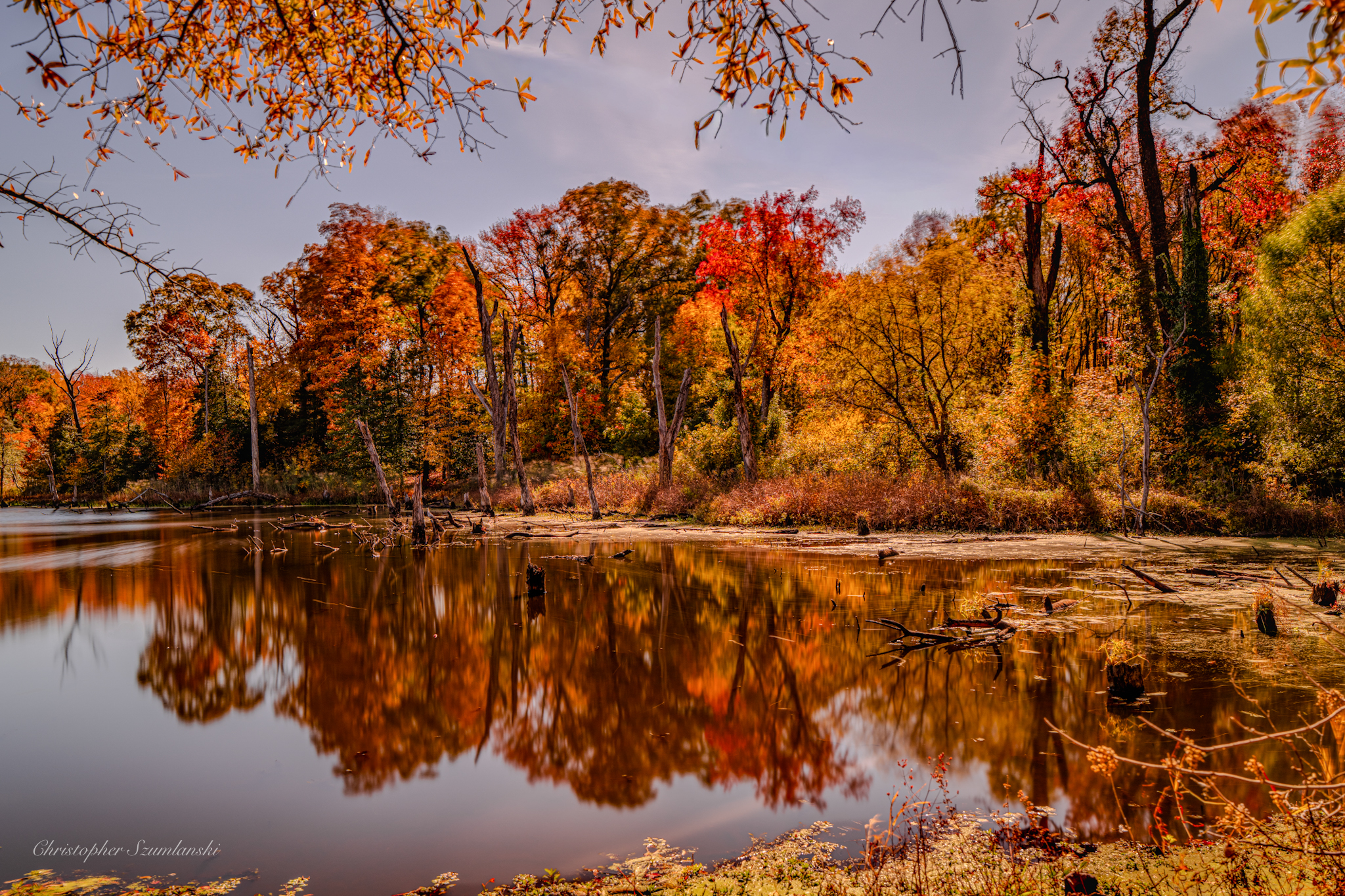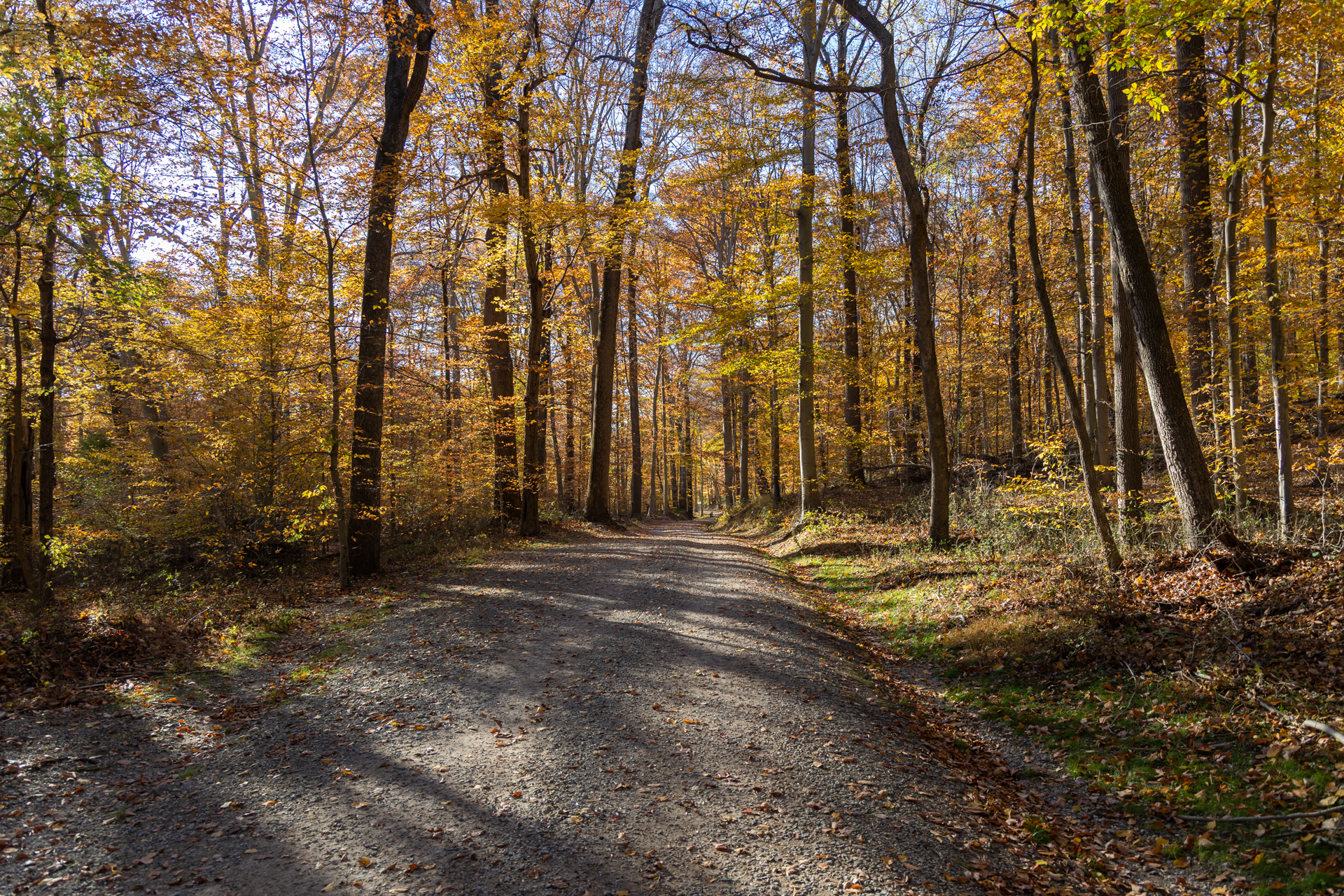Leaves in western Maryland are well past peak, as are leaves in central Maryland. Lots of crunching underfoot.
On the Eastern Shore, leaves are at their peak, with some vivid hues on display along fields and roads. Sweet gums and black cherry trees are turning orange and yellow; shrubs like lowbush blueberry are turning light green and yellow. Staghorn sumac is showing off vibrant reds.
This is our last weekly report for the year – thanks to the foresters and rangers who offered field reports, and to the public who submitted photos!
We hope you tune in again in 2026!
Frederick County, Forester Dakota Durcho
Foliage in Gambrill State Park.
Color change is now past peak, along the ridgetop of Catoctin Mountain. Wind has continued to bring down many leaves. Temperatures have remained consistent, being in the 40s at night, which has helped push things along. At this point leaf color is beginning to dull, with most transitioning to brown. In the Piedmont, color is still at peak in areas, however this too will taper off in the next week or so.
All trees have or are continuing to change at this point. Complete leaf drop will likely be noted by the end of November.
Cecil County, Ranger Lesley Leader
Fair Hill Natural Resource Management Area
Somerset County, Forester Rachel Egolf
There is still plenty of fall color to see in Somerset County. If you are searching for light this week, the Lower Shore ramps up the fall colors for our viewing pleasure. The morning sun glistening through the branches of a tree, playing with different values of light and dark, may be completely devoid of leaves the next day. Trees such as red oaks (Quercus rubra), and American beech (Fagus grandifolia) sometimes have leaves that brown and hang on through the fall and winter.
The low bush blueberry shrubs (Vaccinium angustifolium), high bush blueberry (Vaccinium corymbosum), and many greenbriar species (Smilax rotundifolia and others) in the woods are turning pale green to yellow. These shrubs and many other varieties will sustain deer through the fall and winter. Also turning yellow and orange are sweet gums (Liquidamber styriciflua) and black cherry (Prunus serotina). Occasionally sweet gum turns a deep burgundy shade that stands out amidst all the oranges and rust colors of sassafras, red maples and red oaks. Staghorn sumac (Rhus typhina) are particularly vibrant this time of year with bright red, maroon or orange colored leaves and persistent fuzzy fruit that are loved by many species of birds.
There is still plenty of green here on the deciduous trees. With the forecast of colder nighttime temperatures and the light disappearing so quickly at the end of the day, it pays one to pause and appreciate the colors all around.
Worcester County, Shad Landing Camp Store Manager Janet Heaton
Fall foliage is at its peak, with leaves starting to drop from trees.
The ponies at Assateague Island are also starting to grow in their winter coats, a sign of fall here on the Eastern Shore.
Rabbit season opened Nov. 1. Small game hunting is a great way for novice hunters to develop woodsmanship skills. Learn more about Maryland’s small game hunting on our website.
The fall foliage makes a great backdrop for fishing – check out the hues while waiting for your bite. Check out our weekly Fishing Report and stocking update below:
Check out this first-hand hunting report from a DNR staffer which follows the first-time hunting experience a man had at age 89:
We have a few meteor showers to chat about. The Taurids Meteor Shower peaks on the evening of November 11 and the following morning. Ideal time will be just after midnight through dawn. The ZHR (meteors per hour) will be around 15. Look towards the constellation Leo, but you could see meteors just about anywhere in the sky.
The Leonids are around for most of the month. The peak is around November 17. There can be bright meteors associated with this shower. Meteors will not be visible until midnight as the radiant will be below the horizon. Look east from midnight through the morning. The best viewing will be closer to the morning since the radiant point will be highest in the sky. The new moon will be three days away so the sky will be dark and create perfect conditions for viewing.
On November 21, if you have a telescope, you can catch a glimpse of Uranus. It will be as close as it will be all year. Look for a little blue-green dot. It will be visible most of the night. Closer to home there will also be a conjunction of the Moon and Mars. The Moon will be a waxing crescent, at only 3%.
On November 29 there will be a close approach and conjunction of the Moon and Saturn. They’ll be southeast from dusk until around midnight.
The faint “winter Milky Way” will be visible now through February and you’ll have to have dark conditions closer to the new moon. The galactic center is no longer visible and will return to our part of the world in the spring and summer. But the winter view offers cool groups of star clusters like the Christmas Tree Cluster and M47, and nebulae such as the Orion.








